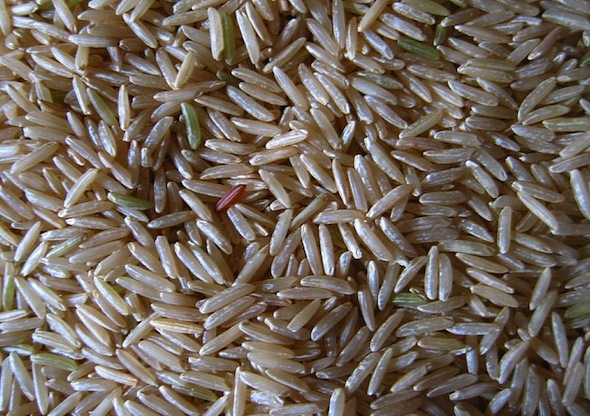Days after Consumer Reports released their findings of arsenic in organic rice baby cereal, rice breakfast cereals, brown rice, and white rice, the FDA has stepped up to the plate so to speak and started their own investigation. Consumer groups have publicly asked the FDA to do it’s job. The question — is it safe to consume rice products with levels of arsenic, a known carcinogen — needs an answer.
Brown rice has higher levels of arsenic than white rice
The Consumer Reports investigation found higher levels of arsenic in brown rice than white rice. It also found higher levels in rice produced in Southern U.S. states than in rice from California or Asia.
Arsenic is naturally present in water, air, food and soil in two forms, organic and inorganic. It is released from volcanoes and from the erosion of mineral deposits. Organic arsenic passes through the body quickly and is thought to be harmless.
Inorganic arsenic is a carcinogen
Inorganic arsenic is found in some pesticides, herbicides, wood preservatives and of course chicken feed. It also comes from burning coal, oil, gasoline and wood. Inorganic arsenic can be toxic and may pose a cancer risk if consumed (or handled) at high levels or over a long period of time.
Scientists have known for decades that arsenic is present in rice, but with better technology, they can measure inorganic and organic arsenic separately.
Arsenic gets into plant foods because it is part of the rocks, soil, air and water. There are many plant foods, including all grains that have low levels of arsenic because it is so prevalent in the environment.
However, rice is especially vulnerable because it is typically grown in water.
Drinking water used as a standard
The Consumer Reports investigators used New Jersey’s drinking water standard as comparison because it is one of the strictest in the country. They allow a maximum of 5 micrograms of arsenic in a liter of water.
However, no one is sure how accurate it is to compare arsenic levels in water and arsenic levels in rice because most people consume more water than rice. Drinking water standards may need to be tougher than food standards.
Arsenic levels may vary widely in the same product
Arsenic levels can vary greatly from sample to sample, even within the same product. FDA’s testing of the initial samples found these average levels of inorganic arsenic in micrograms (one millionth of a gram):
- Rice (other than Basmati rice): 6.7 per 1 cup (cooked)
- Rice cakes: 5.4 per 2 cakes
- Rice beverages: 3.8 per 240 ml (some samples not tested for inorganic arsenic)
- Rice cereals: 3.5 per 1 cup
- Basmati rice: 3.5 per 1 cup cooked
A Long term study reveals arsenic exposure through rice
U.S. Researchers at the Dartmouth Children’s Environmental Health and Disease Prevention Research Center in late 2011 published a small study that indicated consuming slightly more than a half-cup of cooked rice per day resulted in a significant increase in urinary arsenic levels. This was comparable to drinking a liter of water containing the federal maximum of 10 ppb arsenic.
These results were particularly worrisome because the participants were pregnant women. Urine samples and three-day dietary records from pregnant women were collected at pre-natal visits. They found that each gram of rice consumed was associated with a one percent increase in total urinary arsenic. These results indicate that consuming slightly more than half a cup of cooked rice per day results in a total urinary arsenic concentration comparable to drinking a liter of water containing the maximum 10 ppb total arsenic limit permissible in public drinking water.
The authors conclude that “many people in the U.S. may be exposed to potentially harmful levels of arsenic through rice consumption.”
Don’t worry about the arsenic says FDA
The FDA is still recommending a “wide variety of grains” in the diet, and no change to the eating habits of Americans. What about people who consume rice every day? What about all the different rice products such as rice milk that toddlers and children drink?
What about the baby foods
Consumer Reports tested several brands of rice baby food. They found that,
Among the four infant cereals tested, we found varying levels of arsenic, even in the same brand. Gerber SmartNourish Organic Brown Rice cereal had one sample with the highest level of total arsenic in the category at 329 ppb, and another sample had the lowest total level in this category at 97.7 ppb. It had 0.8 to 1.3 micrograms of inorganic arsenic per serving.
Earth’s Best Organic Whole Grain Rice cereal had… inorganic arsenic per serving — from 1.7 to 2.7 micrograms.
So what’s a parent to do? To reduce arsenic risks, we recommend that babies eat no more than 1 serving of infant rice cereal per day on average. And their diets should include cereals made of wheat, oatmeal, or corn grits, which contain significantly lower levels of arsenic, according to federal information.
According to federal data, some infants eat up to two to three servings of rice cereal a day. Eating rice cereal at that rate, with the highest level of inorganic arsenic we found in our tests, could result in a risk of cancer twice our acceptable level.
FDA to test 1200 foods
Once FDA has completed its analysis of about 1200 rice products, the agency will analyze these results and determine whether or not to issue additional recommendations.
According to Michael Taylor, FDA’s deputy commissioner for food,
It is critical to not get ahead of the science… The FDA’s ongoing data collection and other assessments will give us a solid scientific basis for determining what steps are needed to reduce exposure to arsenic in rice and rice products.”
According to FDA Commissioner Margaret Hamburg,
Our advice right now is that consumers should continue to eat a balanced diet that includes a wide variety of grains – not only for good nutrition but also to minimize any potential consequences from consuming any one particular food.
Traditional preparation of rice will help
If you would like to continue to eat rice, the best way to prepare it is by soaking overnight in water. This will help remove some of the arsenic and other unwanted aspects of the grain such as phytic acid and enzyme inhibitors. Consumer Reports also suggests cooking it in a ratio of six parts water to one part rice. All of this will help.
A novel solution
Eating a variety of grains to reduce exposure sounds like good advice, but for people who are gluten-free, like those with celiac disease, rice has been a safe starch. They cannot eat other grains and they should not eat other grains.
Here is a novel solution — go grain-free. Free yourself from eating all grains and you will allow your body to recover from irritating and immune stimulating foods and this will help recover your health.
Go grain-free
A grain-free diet has been used to improve many conditions. Check out my online grain free cooking class, Go Grain Free with the bonus bundle of my grain free Breads, Snacks and Desserts e-book!













